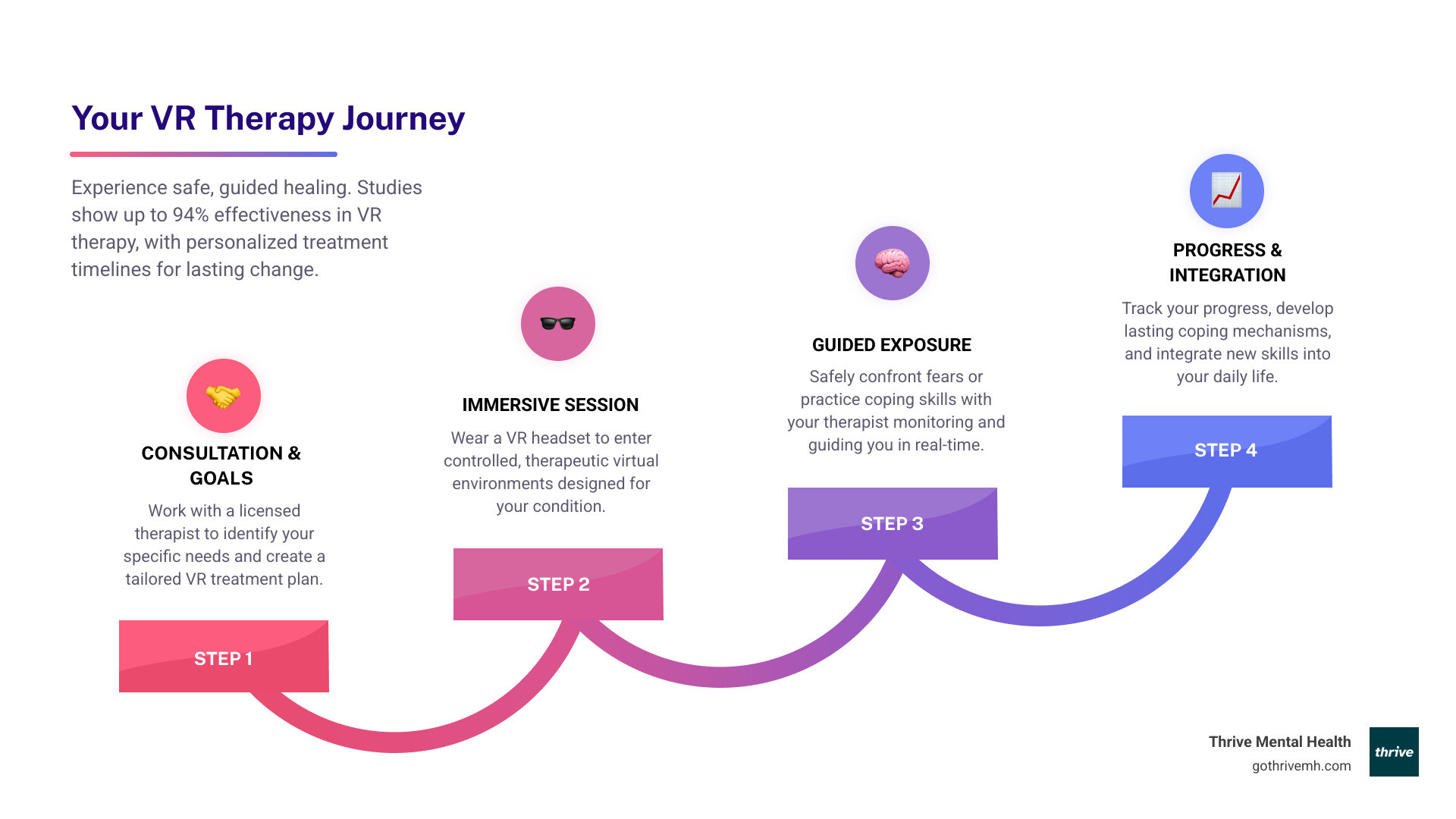Reality Check! Your Guide to Virtual Reality Therapy in Arizona

Why Virtual Reality Therapy is Revolutionizing Mental Healthcare in Arizona
Virtual reality therapy Arizona options are changing how people access and experience mental health treatment, offering immersive, evidence-based solutions that go far beyond traditional talk therapy. This innovative approach uses computer-generated environments to help patients safely confront fears, process trauma, and develop coping skills in controlled virtual settings.
Quick Guide to Virtual Reality Therapy in Arizona:
- What it treats: Phobias, PTSD, anxiety disorders, addiction, chronic pain, and social skills challenges.
- How it works: Patients wear VR headsets to experience therapeutic scenarios guided by licensed professionals.
- Key benefits: Safer exposure therapy, increased engagement, personalized treatment, and faster results than traditional methods.
- Availability: Offered through specialized clinics, telehealth platforms, and integrated treatment programs.
- Insurance: Coverage varies by provider; many sessions qualify under standard psychotherapy billing codes.
- Success rate: Over 30 clinical trials show VR Exposure Therapy (VRET) matches or exceeds traditional exposure therapy effectiveness.
Virtual reality therapy combines the proven principles of Cognitive Behavioral Therapy (CBT) with cutting-edge technology. Instead of relying on imagination or real-world exposure that might feel overwhelming, patients can gradually work through challenging situations in a safe, controlled virtual environment.
The technology addresses a critical gap in mental healthcare accessibility. Whether you’re dealing with a fear of flying, recovering from trauma, or managing social anxiety, VR therapy offers a middle ground between imagination-based techniques and potentially triggering real-world exposure.
Arizona has emerged as a hub for innovative mental health solutions, with providers integrating VR therapy into comprehensive treatment programs. The state offers diverse options for those seeking this cutting-edge approach.
As CEO of Thrive Mental Health, I’ve witnessed how innovative technologies can break down barriers to effective mental health care, making virtual reality therapy Arizona programs more accessible to busy professionals who need flexible, evidence-based treatment options. My experience leading behavioral health initiatives has shown me that the future of mental wellness lies in combining proven therapeutic approaches with technologies that meet patients where they are.

How VR Therapy Transforms Mental Healthcare
Virtual reality therapy, or VRT, is a modern psychological treatment that uses immersive virtual environments to help individuals address a range of mental health challenges. Imagine confronting your deepest fears or processing traumatic memories in a space that feels real but is completely safe and controlled. That’s the power of VR therapy.

At its core, VR therapy creates computer-generated, three-dimensional worlds that simulate real-life scenarios. When a patient wears a VR headset, they are transported into this world, engaging multiple senses to create a highly immersive experience. This immersion is key because it allows the brain to respond to the virtual stimulus as if it were real, triggering authentic emotional and physiological reactions.
One of the most common applications is Virtual Reality Exposure Therapy (VRET), a specialized form of Cognitive Behavioral Therapy (CBT) we use at Thrive Mental Health. Traditional exposure therapy can be difficult or impractical. VRET offers a powerful alternative by allowing patients to experience feared scenarios in a controlled, virtual setting. For instance, someone with a fear of heights might virtually climb a mountain, or a person with claustrophobia might experience a virtual elevator.
The therapist remains in control, adjusting the intensity of the exposure based on the patient’s reactions. This ensures safety and minimizes the risk of retraumatization. The brain learns that the feared stimulus is not dangerous, which helps rewire neural pathways through neuroplasticity. This gradual desensitization leads to a reduction in anxiety and fear in the real world.
The engaging nature of VR therapy also increases patient motivation. It can make the therapeutic process more enjoyable, leading to higher engagement and quicker recovery. Our approach at Thrive Mental Health is always evidence-based, and the efficacy of VRET is supported by over 30 randomized controlled trials. To learn more about the foundational principles of this approach, explore A Beginner’s Guide to Cognitive Behavioral Therapy (CBT).
Conditions Treated with Virtual Reality
The versatility of VR therapy allows it to address an impressive spectrum of mental health conditions. Its applications extend far beyond its well-known use for phobias like fear of heights, flying, or public speaking. VR can effectively treat anxiety disorders, PTSD, and trauma by allowing individuals to process memories and practice coping skills in a safe space. It is also used for addiction and cravings, simulating high-risk situations to practice relapse prevention. Additionally, VR helps with pain management, depression, stress reduction, and behavioral issues like anger management. For individuals with ADHD or Autism Spectrum Disorder (ASD), it offers interactive exercises to improve focus and practice social skills.
Our online anxiety support programs at Thrive Mental Health often leverage the principles of exposure and cognitive restructuring, which align perfectly with the capabilities of VR therapy. Explore more about how we can support you through Anxiety Support Online.
Key Benefits Over Traditional Methods
Virtual reality therapy offers several compelling advantages over traditional therapeutic approaches:
- Improved Safety and Control: VR environments are completely safe. A therapist can control every aspect of the scenario, adjusting intensity and pausing the session at any moment.
- High Accessibility and Convenience: VR therapy can often be delivered remotely, overcoming geographical barriers. This means quality mental healthcare can be accessed from home, a core benefit of our virtual programs at Thrive Mental Health. Patients can even have VR headsets shipped to them for telehealth sessions, making virtual reality therapy Arizona and beyond more accessible than ever.
- Increased Patient Motivation: The immersive and interactive nature of VR makes therapy more engaging and less daunting, boosting motivation and leading to more consistent participation.
- Personalized Scenarios: Therapists can tailor virtual environments to specific patient needs and goals, allowing for highly individualized treatment plans.
- Confidentiality and Privacy: VR provides a private space to experience challenging situations without the discomfort of real-world interactions.
- Faster Results: Many patients experience improvements within just a few sessions. Studies show significant reductions in emotional reactions, leading to quicker overall progress.
The combination of safety, accessibility, and efficacy makes VR therapy a truly transformative tool. We believe in using these benefits to provide effective, flexible, and evidence-based care. Find more about the broader advantages of seeking mental health support in our article, 5 Benefits of Mental Health Therapy You Should Know.
Accessing Virtual Reality Therapy in Arizona and Beyond
Finding virtual reality therapy Arizona options is becoming easier as this innovative approach grows in popularity. The mental healthcare landscape is evolving, and immersive technology is playing a key role in helping people heal.

You can find VR therapy integrated into various settings, including specialized mental health clinics, rehabilitation centers, and the practices of individual psychotherapists. Many are adding VR tools to their practice, with some offering remote sessions you can do from home.
This brings us to the exciting world of telehealth platforms. The rise of virtual behavioral health has opened doors, making quality care accessible from anywhere and overcoming geographical barriers. At Thrive Mental Health, this accessibility is at the heart of what we do. It’s about bringing innovative solutions right to you, no matter where you are in Arizona or beyond. If you’re curious about how virtual care is reshaping the mental health world, check out The Rise of Virtual Behavioral Health: Changing Mental Healthcare.
As you explore options for virtual reality therapy Arizona, remember to ask questions about their specific VR programs and how they fit into a bigger picture of your well-being.
What to Look for in a Virtual Reality Therapy Arizona Provider
Choosing a provider for virtual reality therapy Arizona is a critical step. You want a qualified, ethical guide for this immersive journey who truly understands your needs.
- Licensed Professionals: Always look for licensed professionals with credentials like LCSW, LPC, or a board-certified psychiatrist. This ensures they meet strict standards and follow ethical guidelines.
- Evidence-Based Protocols: Ensure their VR therapy is rooted in proven methods like Cognitive Behavioral Therapy (CBT), Exposure and Response Prevention (ERP), or Eye Movement Desensitization and Reprocessing (EMDR).
- Specialized Training: The therapist should have specialized training in using VR for therapeutic purposes, ensuring they can manage both the technology and your clinical needs.
- Ethical Standards: The provider must adhere to high ethical standards for privacy, informed consent, and creating a safe space, as outlined by organizations like the American Psychological Association (APA). You can learn more here: Ethical standards from the APA.
- Comprehensive Treatment Plan: The best providers integrate VR into a holistic plan that may include individual sessions, group therapy, or mindfulness practices.
- Patient-Centered Approach: Your provider should be open, honest, and listen to you, making sure you feel comfortable and understood every step of the way.
At Thrive Mental Health, we believe that finding the right mental healthcare provider is about building a trusted partnership. For more guidance on choosing the best fit for your mental health journey, take a look at Key Considerations in Choosing a Mental Healthcare Provider.
The Role of VR in Physical and Mental Rehabilitation
Beyond its use in mental health, VR is also a superstar in physical and cognitive rehabilitation. This innovative tech is helping people recover from neuro-physical conditions in a way that is both effective and engaging.

For individuals recovering from strokes, brain injuries, or managing conditions like Parkinson’s, VR offers a safe environment to practice balance and movement without the real-world risk of falling. It also boosts physical therapy integration by turning repetitive exercises into exciting games, which increases motivation.
VR is also a game-changer for neurotherapy and cognitive rehabilitation. It challenges the brain with engaging tasks to improve attention, problem-solving, and visual processing, which is especially helpful after a traumatic brain injury (TBI). By transporting patients to calming virtual worlds, it can also aid in pain reduction.
Advanced VR systems can provide data-driven progress by collecting biomechanical analysis, tracking movements to give therapists precise information to tailor recovery plans. The technology is also being explored for compassionate care in hospitals, showing how VR is about more than just tech; it’s about enhancing human connection and healing.
The Synergy of VR with Other Proven Therapies
One of the most exciting aspects of virtual reality therapy is how well it integrates with other trusted healing methods. Think of VR not as a standalone treatment, but as a powerful tool that can improve other therapies, making them more effective, accessible, and engaging.
EMDR Integration
Eye Movement Desensitization and Reprocessing (EMDR) is a powerful treatment for trauma and PTSD. While highly effective on its own, adding VR (EMDR-VR) offers significant benefits.
Here’s a quick look at how VR can boost traditional EMDR:
| Feature | Traditional EMDR | VR-Improved EMDR |
|---|---|---|
| Bilateral Stimulation | Guided eye movements, tapping, or auditory tones. | VR provides dynamic, immersive visual bilateral stimulation. |
| Visualization | Relies on the client’s ability to imagine scenes. | VR displays scenes directly, which is helpful for those who struggle with visualization. |
| Emotional Reactivity | Can be intense, requiring strong grounding skills. | Elicits authentic reactions in a controlled, safe virtual space. |
| Distraction Control | External distractions can interrupt processing. | VR eliminates distractions and improves focus. |
| Accessibility | Requires in-person presence or careful remote setup. | Allows for effective remote EMDR-VR sessions. |
| Re-traumatization Risk | Low, but clients may feel overwhelmed. | Minimized by controlling triggers and allowing an immediate exit from the scene. |
By using a controlled, immersive setting, VR can make the bilateral stimulation in EMDR smoother and more impactful. It also allows therapists to gently introduce visual cues related to the trauma, which can speed up desensitization. We know how deeply trauma can affect someone, and our programs are here to offer full support. Learn more in our guide on How EMDR Therapy Reduces PTSD Symptoms and Boosts Mental Health or explore our Treatment Modalities: Virtual IOP/Mindfulness Meditation Virtual IOP.
Integration with Other Modalities
VR’s flexibility allows it to improve many other therapeutic approaches.
- Cognitive Processing Therapy (CPT): A type of CBT that involves processing difficult memories. VR can provide a safe, structured space to revisit and re-evaluate these memories, making the exposure component more manageable.
- Mindfulness and Meditation: VR can create peaceful, immersive environments like a virtual beach or quiet forest. This helps users focus on guided meditations and breathing exercises, which is especially helpful for managing anxiety and stress.
- Other CBT-Based Therapies: VR can be woven into therapies like Dialectical Behavior Therapy (DBT) or Trauma-Focused CBT (TF-CBT). It provides realistic scenarios where patients can practice new skills, such as emotional regulation or distress tolerance.
The true strength of VR is its ability to create a personalized, controlled, and immersive space that can improve almost any evidence-based therapy, making the healing journey more effective and engaging.
Frequently Asked Questions about VR Therapy
As virtual reality therapy Arizona options become more popular, it’s normal to have questions about cost, side effects, or how long it takes to see results. We’re here to clear things up.
Is Virtual Reality Therapy Covered by Insurance in Arizona?
The answer often depends on your specific health plan. Insurance coverage for VR therapy in Arizona varies, but it is becoming more common. Often, VR therapy sessions are billed using the same CPT codes as standard psychotherapy (like 90834), making coverage more likely when it’s part of a session with a licensed professional.
Our best advice is to contact your insurance provider directly to ask if they cover “virtual reality therapy” or “VRET.” If a provider is out-of-network, you may be able to get reimbursement by submitting a “superbill.” At Thrive Mental Health, we work with a variety of insurance providers to make care as accessible as possible. For more details, check out our page on Virtual IOP Insurance.
What Are the Potential Side Effects or Limitations?
While VR therapy is generally safe when guided by a professional, there are a few things to be aware of. Some users may experience mild and temporary “cybersickness” (dizziness or nausea) or eye strain, which usually subsides after the session. Taking breaks can help.
It’s also important to remember that VR is a powerful tool, not a standalone cure. It works best as part of a comprehensive treatment plan. The success and safety of VR therapy depend heavily on a trained and experienced therapist who can manage the technology and provide proper clinical support.
VR therapy may not be suitable for everyone. Contraindications include certain medical conditions (like seizure disorders), being under the influence of substances, or experiencing acute illness. It’s crucial to discuss your medical history with your doctor and therapist before starting. At Thrive Mental Health, your safety is our top priority, and we carefully screen every individual to ensure VR therapy is a good fit.
How Long Does VR Therapy Take to Show Results?
Everyone’s healing journey is unique, so the timeline for results varies. For specific phobias, many people see significant improvement in just a few sessions. For more complex issues like PTSD or addiction, treatment will naturally take longer to build lasting change, though some relief may be felt quickly.
Consistency is key. Regular sessions help the brain rewire its responses through repeated, controlled exposure. One of the most exciting things about VR therapy is that it can lead to faster results than some traditional methods. Research shows VRET is as effective, or even more so, than real-life exposure because it allows for precise control and repetition. Some studies have shown that 94% of people immediately improved in a single session.
At Thrive Mental Health, we focus on evidence-based practices that bring real, positive changes. To hear more about how these therapies are changing lives, take a look at our article, Changing Lives: Cognitive Behavioral Therapy Success Stories.
The Future of Healing is Virtual
The world of mental healthcare in Arizona is buzzing with new ideas, and virtual reality therapy Arizona is leading the way. As we look ahead, we can expect even more incredible breakthroughs as VR technology shapes a more personal and engaging path to healing.
The future of VR therapy holds exciting possibilities:
- Increased Accessibility: As VR headsets become more affordable and telehealth grows, VR therapy will become available to more people, especially those in remote areas or who have difficulty leaving home. This aligns with our mission at Thrive Mental Health to offer care that’s easy to reach through our virtual programs.
- AI Integration: Artificial intelligence will likely make VR therapy even more personal. AI could adapt virtual scenes in real-time based on a user’s physiological reactions, creating a truly dynamic and responsive therapeutic experience.
- Personalized Healing: Future VR tools will offer deeper customization, allowing therapists to create highly specific scenarios matched to an individual’s unique experiences with trauma, phobias, or social challenges.
- Patient Empowerment: VR gives you a real sense of control over your healing. You actively participate, facing fears at your own pace and practicing coping skills in a safe virtual space, which helps build inner strength and confidence.
- Integration with Wearable Tech: Wearable devices that monitor heart rate or other biometrics will likely connect with VR systems, giving therapists real-time insights to further personalize treatment.
At Thrive Mental Health, we believe the future of mental wellness lies in combining proven therapeutic methods with innovative technologies that meet you where you are. We are committed to embracing these advancements to provide flexible, expert-led, and evidence-based care that changes lives for the better. Virtual therapy, including the amazing possibilities of VR, is a core part of this bright future. To find out more about how technology is changing mental healthcare, check out our page on Virtual Therapy: A Convenient and Effective Approach to Counseling.